return to homepage DENNIS HOPPER:
return to updates
by Miles Mathis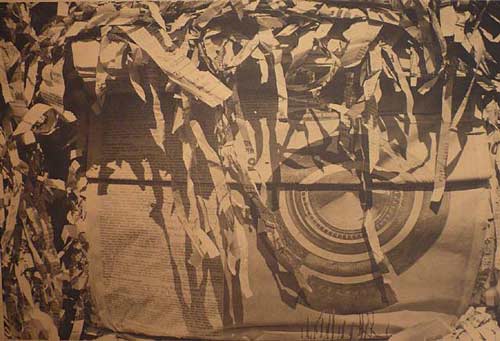
Dennis Hopper, photo of newspaper with shredded newspaper
Dennis Hopper is having two shows open this week (May 8, 2009) at the Harwood Museum in Taos, New Mexico. One is a show of his “art.” In the other, he is “curating” a show of some of his friends' “art.” To begin with, let us look at some examples of Hopper's art and his friends' art.

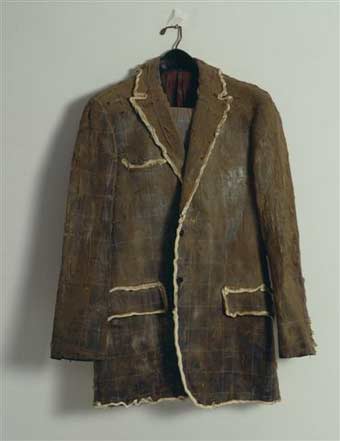


Ron Cooper, Puro Chingon Ronald Davis,
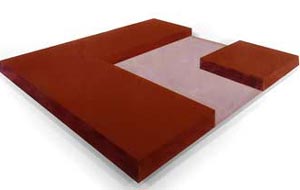
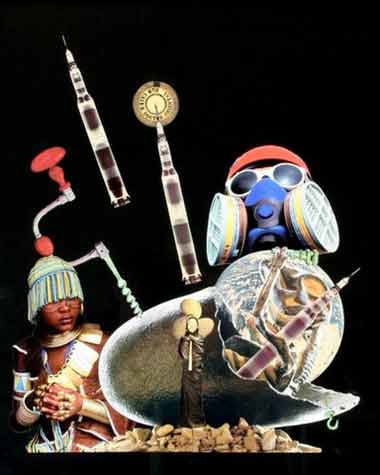
Ronald Davis, 6/9ths red Dean Stockwell, What goes up, collage
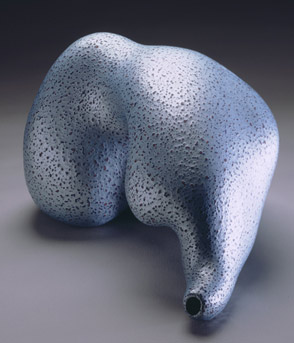

Ken Price, sculptures
I don't even need to critique these works: they speak for themselves. This is art for the creatively impaired. We have all seen better art by elephants and chimpanzees. Gerbils have more imagination than this. Pigeons cooing are more expressive. Porpoises smiling at us from their glassy dungeons have a better sense of humor than Larry Bell with his snot on suede. Even a goldfish in a bowl exudes a clearer understanding of art, since it intuitively glides through the water with beauty and grace, uncued by critics.
This last stab is not gratuitous, since we must remember that Hopper put up one of the greatest cinematic bombs of all time, the notorious Last Movie, and he did it by listening to Alejandro Jodorowsky, the king of psychomagic, psychobabble and artbabble. Hopper, like all the other modern artists here and everywhere else, lives under the continual influence of outside opinion and criticism. These people cannot exist artistically without an external cue and a fish thrown from the trainer. They must mirror expectations because they have nothing within to go on.
In that famous scene from Apocalypse Now, Brando is reading from T. S. Eliot: "We are the hollow men, We are the stuffed men." Remember, he was talking to Hopper: the hollow man, the stuffed man. Hopper was mouthing big words with wild eyes (he does this in real life just as in the film—playing himself as usual—tough acting, that): words like physics and dialectics, and Brando threw the book of poetry at him, yelling, "you mutt!" These days, Hopper does the same character, but he does it in real life, and he does it with art instead of poetry or philosophy. He wears an Armani suit and $500 sunglasses and a Republican tie pin instead of a red bandana and beads, but he is still the same character, mouthing empty words. He uses words like "art" and "artist" without having any idea what they mean, just to look like an intellectual. Which gives me the chance to play the Brando character. Yes, I get to be Colonel Kurtz. I get to throw the book of art at Hopper and shout, "You Mutt! You know nothing about art! Your art and your idea of art is
Shape without form, shade without colour,
Paralysed force, gesture without motion
And this applies to the art of your friends and all the art you surround yourself with and all the people you surround yourself with! You are a "headpiece filled with straw." In Taos you are truly the prince of the "dead land, the cactus land." And the people at the Harwood are "gathered on this beach of the tumid river", with their dry voices, not quiet but indeed meaningless,
As wind in dry grass
Or rats’ feet over broken glass
Yes, clearly Hopper has used his minor Hollywood fame to buy himself and his friends into the field of art. In the past, if someone bought himself into a field, we would call him a fake. But since Hopper has bought himself into contemporary art, which was already a fake field, we can say that he is doubly fake. By presenting nullities as art, Hopper has acted like a contemporary artist, and since contemporary art is an act to begin with, nobody can tell the difference between the first act and the second act. Are we removed once from art here, or twice? Do we have commentary, or a commentary upon a commentary? Hard to say. All that we can say for certain is that we once again have nothing sold to us as something.
Well, no, we can also say for certain that getting your friends into the museum is not curating. Curating is normally defined as choosing art based on its merits, not on personal connections, but in the modern world all definitions and customs have been jettisoned. During most of the history of art, using the museum to have shows for your friends would have been seen as tasteless, if not illegal. Don't most museums have something in their charter forbidding cronyism? Even in this day and age, I think the public would be distressed to find that a museum curator was choosing works for personal reasons, but no one has blinked an eye when the museum brings in an actor to “curate,” and he “curates” into the show a bunch of his old buddies. The museum doesn't even try to hide the corruption: it boldly promotes the cronyism as something unremarkable, laudable even.
I made this rather obvious argument to a stranger in a bar, and that stranger (who turned out to be “in the arts”) got quite offended. I said, “What the fuck does Dennis Hopper know about art?” She responded, “He knows a lot more than you do. He judged the Turner Prize, he has been in museum shows all over the world, has won many honors, and he owns a huge collection of modern art.” I answered, “No, you don't know me. You are getting 'you' and 'me' confused. Hopper may know more about art than you do, but Kermit the Frog (another famous Hollywood person) knows more about art than you do. The Turner Prize is not art, it is anti-art. So being there to hand out the prize has nothing to do with art. Hopper wasn't even a judge, he was just a presenter. To be a judge, you had to be a major intellectual like Neil Tennant of the Pet Shop Boys, who knows almost as much about art as Elmo or Bart Simpson.”
As for the rest, receiving awards from dishonorable people is not the same thing as winning honors. We have an another imprecision in vocabulary here. Dick Cheney has received lots of awards and even “honorary” degrees. That does not make him honorable. And showing in museums does not make you an artist. One might as well say that killing innocent women and children at the Washita River makes you a soldier or that shooting a charity basket at halftime (and missing) makes you an NBA player.
And if we look at Hopper's collection of art, we find a large stash of works like the ones above. This is not proof that he knows art, it is proof that he knows nothing about art.
Of course all this just made the lady “in the arts” madder, and she finally played her trump card. She said, “Look, art isn't about beauty anymore. That is passé. Dennis Hopper is a progressive and that is why I respect him more than I do you.”
First of all, she still didn't know who I was, so this only meant, “I respect him more than I respect someone who doesn't agree with everything I say.” But rather than pursue that logic, I pursued this logic: I said, “progressive in what way?”
She said, “Well, he is a modern artist. He believes in democracy. He is not for that old humdrum about aristocratic art for Kings and Popes.”
Perfect, since that allowed me to play my trump card. I said, “Really? So that is what modern art is about? If that is the case, then I challenge Hopper to a democratic and artistic duel. Let us both put our art in the same museum, invite the public for free, and let them vote on who is the real artist. Voting is democratic, wouldn't you say? Next to my work, his would look like mouse droppings.”
At that point she went a bit pale. Even though she didn't know who I was, my confidence frightened her. She hemmed and hawed, and finally said it was a moot point, since it wouldn't ever happen. And I agreed with her. It won't ever happen because they know the outcome as well as I do. They can talk the talk of democracy, but they can't walk the walk. They don't want fairness or democracy, they want the museum and all the “cultural” attention for themselves, and they want to exclude anyone that threatens them. They don't want to encourage the public to come to the museum, by displaying real art; they want to discourage the public from coming, by putting up fake art. This assures their continued hegemony as administrators. If you brought back real art, you would also have to hire real administrators—people who knew something about art. As it is, any star-kissing phony can become a museum director or staff worker. Or I should say, only the star-kissing phonies can become museum staff, since only the phonies fit into the current order of business.
Since the entrenched philistines will never allow someone like me to show next to Hopper, let us create a little virtual museum.

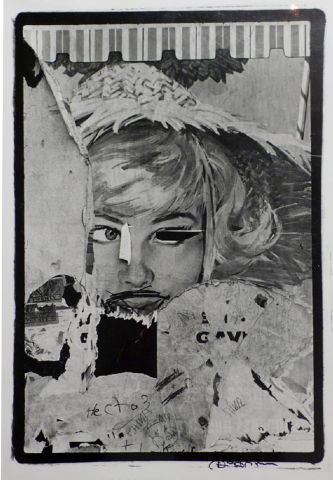
(click to go to details)
Here we have a fifteen-foot tall triptych, with oil painting, poetry in calligraphy, sculpture, and woodworking, against an 8 x 12” photo-montage. I said Hopper's work would look like mouse droppings, but that turns out to be too generous. Mouse droppings, as contemporary art, would actually be more powerful than Hopper's attempts at contemporary art. Since contemporary art is anti-art, what he should have been looking for is something like Duchamp's urinal. That urinal was pretty potent at the time (1917), as a sample of non-art or anti-art. Hopper's pathetic little photo montages don't really get off the starting blocks as either art or anti-art. But if he trucked in a 50,000 gallon plexiglas container from the state aquarium and filled it with fresh mouse droppings, complete with a fan to blow the fumes out into the halls of the Harwood, he might be able to create a great enough ruckus to keep the visitors from looking at my Triptych. That would be his only hope in such a contest.
And that brings us to the final question: How many more decades must we continue to be assaulted with this stuff? We have the power and the numbers to take back the museums from these faux-people: why have we not done it already? Why have almost all the museums in the US and the world been left to this corrupted cabal of conmen and conwomen? This is not historical necessity, this is not "just the way things are." This has happened because those who love art have let it happen. Our village has been invaded and we have not even tried to drive off the invaders. We give them our houses and cattle and wives and children and go live in the swamp. Whose fault is that?
The town museum is the ancestral home of real artists, not of these posers. The town museum is the public possession of the townspeople, and they should feel at home there. They should see art there, not anti-art, non-art, or fake art.
The Harwood in Taos started out long ago as a private museum, but it is now part of the University of New Mexico and is funded in large part by tax dollars. In 2008 it received 1.22 million dollars of public money for expansion. Therefore it is a public institution. It is not the playground of any elite—of aging actors or rich society ladies or self-appointed critics. It is the town museum. A large majority of townspeople, in Taos and every other town, are not interested in the art above, and it is not because they are critically uneducated. It is because they are honest. They cannot be bothered to see a show of snot on suede, much less pay to see it, because it is not interesting in any way. No matter what you title it, art or non-art or anti-art, it is still boring. It is uninteresting artifacts by untalented people, as any child or precocious parrot can see.
The solution is very simple, since all it requires is the citizens taking the museum back. It requires talking and doing. It requires telling these people to be off. It requires firing the museum phonies and not inviting the fake-artists. It requires letter writing and sit-ins and protest, like anything else. It requires petitions and lawsuits. As citizens, we do these things for other causes. Why have we let art die without the least protest? There are still things to put in these museums that people would be interested to see, as I have shown, and if the museums were taken back, more real artists would emerge and more real artifacts would be created. But I can't do it all myself. I can invite the townspeople of the world, I can exhort them, but I cannot force them to show up. I hear a lot about art lovers, but I see very little to prove it. Where are you? Speak up! We need to hear your "YOP!"
If this paper was useful to you in any way, please consider donating a dollar (or more) to the SAVE THE ARTISTS FOUNDATION. This will allow me to continue writing these "unpublishable" things. Don't be confused by paying Melisa Smith--that is just one of my many noms de plume. If you are a Paypal user, there is no fee; so it might be worth your while to become one. Otherwise they will rob us 33 cents for each transaction.